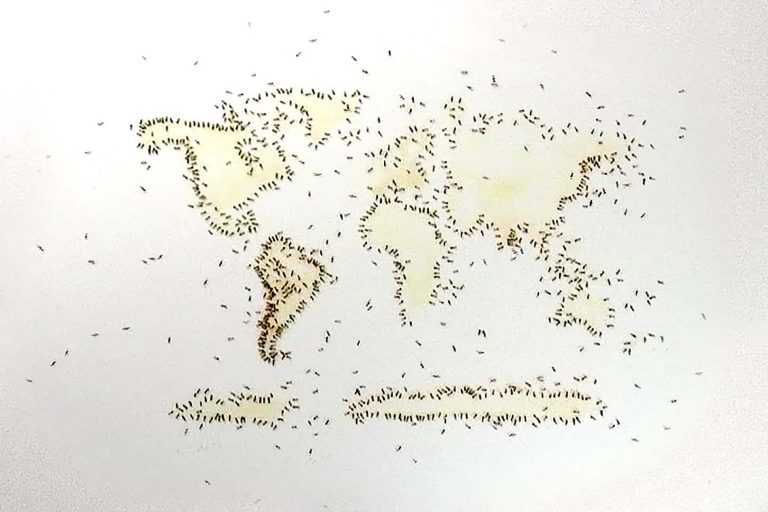We acknowledge the Traditional Owners of the land on which the Queensland Art Gallery | Gallery of Modern Art stands and recognise the creative contribution First Australians make to the art and culture of this country.

Rivane Neuenschwander / Brazil b.1967 / Contingent 2008 / Digital Betacam, DVD and Quicktime file on media player: 10:30 minutes, colour, silent / Purchased 2008. Queensland Art Gallery Foundation / Collection: Queensland Art Gallery | Gallery of Modern Art / © Rivane Neuenschwander
Rivane NeuenschwanderContingent 2008
Not Currently on Display
Rivane Neuenschwander’s Contingent shows a swarm of ants slowly devouring a map of the world made from honey. The ants gather at the border of each continent and gradually move inland. Each landmass becomes smaller and smaller until all that is left is a few ants on an empty plane.
The work offers multiple readings. It plays on layered notions of consumption: the literal hunger of the ants; and the implied consumption of the world’s finite resources. The slowly shrinking honey continents could also represent landforms gradually submerged beneath rising sea levels.
Rivane Neuenschwander is a Brazilian artist known for her ephemeral work that explores narratives around language, nature, geography and the passing of time. Neuenschwander frequently employs a simple framework and materials to convey complex ideas.
Neuenschwander’s work has been described as a contemporary manifestation of the influential avant-garde movement Neo-Concretism, which emerged in Rio de Janeiro in the 1950s and 60s. Neo-Concretism privileged open interpretations of art, as opposed to the strict formalist rules of the previous generation. It emphasised the subjective experience of the viewer and their role in realising the artist’s intent. The neo-concrete artists believed that artworks changed on ‘activation’ by the spectator, and are dynamic encounters rather than static objects.
Discussion Questions
1. Discuss the meaning of ‘ephemeral art’. Does documentation using video or photography change or add meaning to such works?
2. Neuenschwander’s work often features living creatures. What do you think it is about ants that appeals to the artist?
3. Contingent presents a map of the world. However, the ocean surrounding the continents is absent. How does the movement of the ants communicate the idea of water?
Activities
1. Develop and create a 2–3 minute video that explores ideas of water and the passing of time in your local area.
2. Create an artwork in response to Contingent that features a map. Experiment with different ways to destroy or disintegrate the map. Consider how you could allow for different interpretations of your work.
3. Research Neo-Concretism and the leaders of this movement. Why is Neuenschwander’s work regarded as a contemporary manifestation of Neo-Concretism?